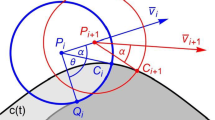Abstract
The majority of mechanical parts are manufactured by milling machines. Hence, geometrically efficient algorithms for tool path generation and physical considerations for better machining productivity with guarantee of machining safety are the most important issues in milling tasks. In this paper, we present an optimized path-generation algorithm for zigzag milling, which is commonly used in the roughing stage as well as in the finishing stage, based on an incomplete two-manifold mesh model, namely, an inexact polyhedron that is widely used in recent commercialized CAM software systems. First of all, a geometrically efficient tool path generation algorithm using an intersection points-graph is introduced. Although the tool path obtained from geometric information has been successful to make a desirable shape, it seldom considers physical process concerns like cutting forces and chatter. In order to cope with these problems, an optimized tool path that maintains constant MRR in order to achieve constant cutting forces and to avoid chatter vibrations at all times is introduced and the result is verified. Additional tool path segments are appended to the basic tool path by using a pixel-based simulation technique. The algorithm was implemented for two-dimensional contiguous end-milling operations with flat end mills and cutting tests were conducted by measuring the spindle current, (which reflect machining situations) to verify the significance of the proposed method.
Similar content being viewed by others
References
Held M (1991) On the computational geometry of pocket machining. Springer, Berlin Heidelberg New York
Patrikalakis NM, Maekawa T (2002) Shape interrogation for computer-aided design and manufacturing. Springer, Berlin Heidelberg New York
Goult RJ, Shearar PA (1990) Improving the performance of neutral file data transfers. Springer, Berlin Heidelberg New York
Persson H (1978) NC machining of arbitrary shaped pockets. CAD 10(3):169–174
Hansen A, Arbab F (1992) An algorithm for generating NC tool path for arbitrary shaped pockets with islands. ACM Trans Graphics 11(2):152–182
Toh CK (2006) Cutter path strategies in high-speed rough milling of hardened steel. Mater Des 27(2):107–114
Held M (1991) A geometry-based investigation of the tool path generation for zigzag pocket machining. Vis Comput 7:296–308
Tang K, Chou S, Chen L (1998) An algorithm for reducing tool retraction in zigzag pocket machining. CAD 30(2):123–129
Park SC, Choi BK (2000) Tool-path planning for direction-parallel area milling. CAD 32(1):17–25
Manuel M, Rodriguez CA (2003) Influence of tool path strategy on the cycle time of high-speed milling. CAD 35(4):395–401
Tlusty J, Smith S, Zamudia C (1990) New NC routines for quality in milling. Ann CIRP 39(1):517–521
Kramer TR (1992) Pocket milling with tool engagement detection. J Manuf Sys 11(2):114–123
Smith S, Cheng E, Zamudia C (1991) Computer-aided generation of optimum chatter-free pockets. J Mater Process Technol 28:275–283
Lee DY, Kim SJ, Lee SG, Yang MY (2003) Incomplete mesh-based tool path generation. Proc SMPE Spring Conference 2003, pp 844–847
Pateloup V, Duc E, Ray P (2004) Corner optimization for pocket machining. Int J Mach Tools Manuf 44(12–13):1343–1353
Iwabe H, Fujii Y, Saito K, Kisinami T (1989) Study on corner cut by end mill analysis of cutting mechanism and new cutting method at inside corner. J Jpn Soc Precis Eng 99(5):841–846
Tsai MD, Takata S, Inui M, Kimura F, Sata T (1991) Operation planning based on cutting process models. Ann CIRP 40(1):95–98
Liu Y, Zuo L, Wang C (1999) Intelligent adaptive control in milling processes. Int J Comp Integr Manuf 12:453–460
Kim SC, Chung SC (1999) Robust cutting force control using indirect force and disturbance estimation in the end milling process. Proc ASPE 20:248–251
Yang MY, Lee TM (2002) Hybrid adaptive control based on the characteristics of CNC end milling. Int J Mach Tools Manuf 42:489–499
Author information
Authors and Affiliations
Corresponding author
Rights and permissions
About this article
Cite this article
Kim, HC., Yang, MY. Incomplete mesh-based tool path generation for optimum zigzag milling. Int J Adv Manuf Technol 35, 803–813 (2008). https://doi.org/10.1007/s00170-006-0757-2
Received:
Accepted:
Published:
Issue Date:
DOI: https://doi.org/10.1007/s00170-006-0757-2



